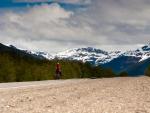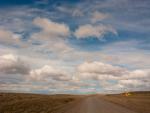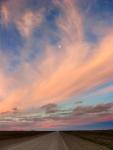South of Guerrero Negro the road kept much of it’s flat nondescript nature. While traveling for days through the dry, dusty, cacti studded flatlands of central Baja, there is a magic that overcomes you when you drop into San Ignacio. This oasis in the desert, not recognized as such from afar, is nestled in a steep-walled canyon. The river water supplies the area with nourishment for an enormous expanse of date palms. A cool breeze always seemed to flow through this town and shade is plentiful. These palms also provide dates to the local shops which they sell in bulk or use to impregnate tasty baked goods. When eating dates, care should be taken to avoid the hazards beset in the path of the famished traveler. It is probably best to pull the date apart by hand then eat it. This eliminates the possibility of cracking tooth or filling on the pit and also illuminates the interior allowing a complete inspection. If you do happen to eat a worm or two, even with it’s leavings, they don’t taste too bad. They are certainly not any reason to avoid this tasty snack altogether in my experience.
In Santa Rosalia, we stayed at an RV park called “Las Palmas”. There we met a very kind RV’er who was in a caravan with 20 others. I had seen many RVs on the roads but this idea struck terror in my heart. The idea of 21 of these behemoths in a chain caused me to unfairly dub this group The Baja Death Squad. As it turns out, when caravaning in a convoy they communicate together via CB which makes passing vehicles and animals (including cyclists) much safer overall. In general if there is a convoy coming I pull off the road and wait.
My riding style while touring is much different than cycling in Seattle. Back home I am typically the cyclist weaving in traffic, pulling my elbows and hands in to scream down the white or sometimes yellow line between two vehicles, and generally beating traffic whenever possible. Here safety is much more of a concern as the bike is less agile, the winds have a greater surface area to push upon, the roads are much narrower, and the time to a hospital is increased. The topic of the intelligence of my choice to ride Baja, the impact upon the traffic, and my riding style was discussed at length on the Baja Nomads forum some weeks back. I learned about the discussion when there were already five pages of comments and posted some information on my riding style. If you care to read the discussion it can be found here. I mention this with some reticence as this thread has made some of my friends angry. Nonetheless I think it’s part of the story. Be sure to read my post on the fifth page, my username is “ridesouth”, and the reactions after that point. I would like to thank those who stood up for me on the forum and kept a cool head. I would also like to re-iterate that cycling Baja is one of the most amazing things I have ever done.
South of Santa Rosalia we came into Mulege. We expected the day to be flat but I was surprised to find a couple good climbs. I really pushed it that day to see if I could make my legs sore. I sprinted all the way to the top, at the end yelling loudly and breathlessly, “DON’T STOP! KEEP CRANKING! KEEP PUSHING!”, perhaps the hardest I have ever ridden on the trip. I was not going to waste the opportunity to wring out every drop of effort and managed to average 35km/hr that day despite the hills. My legs wined and complained like babies but I ignored them as I have learned to do. I was sure they would be sore that night but a few hours later they were back to normal. After this masochistic triumph I entered the town of Mulege.
A banner hung over the entrance to the town center, something about “Feb. 10th Mulege Pig Races”. I knew it was near the 10th but wasn’t really sure of the date. I’m often proud that I have no clue whatsoever of the day of the week or the date; a sort of tribute to Peter Fonda’s throwing of his watch in the beginning of Easy Rider. As I rode through the narrow streets of Mulege, I came upon a covered area milling with gringos. Coated with salt from my previous exertion, I wheeled my bike inside drawing the attention of many. I had arrived just 10 minutes before the race and had a chance to chat with some American transplants about the area and discuss the contenders. Each pig was rigged with a harness and attached to a line to avoid any lane changing fiascoes. The crowd placed their bets and awaited the start. Three men held the pigs down to eliminate any false starts. The athletes squirmed with anxiety, rearing to speed down the track and snatch their porcine victory. The moment arrived, the announcer counted down, and the shot was fired. The pigs immediately sprang out of their captors loosened hands and … well … they sort of stood there. One of them didn’t move much, the other two seemed to have directional issues. The crowd roared with laughter and cheered for the piggie of their wager while the handlers shouted in the pigs ears. They wiggled the guide lines in an attempt to coax them in the right direction. Eventually one of them got the idea to head for the finish and another followed suit. For one stride during the short walk I thought I saw a burst of speed and four hooves meet air but it was short lived. The announcer bellowed the standings as the event progressed, a talented man who possibly rocked the mic at auctions in a past life. Just when everyone thought a finish was imminent the two lead racers stopped, apparently confused by the shouting at the finish. This lack in judgment gave the trailing pig, “Miss Piggie”, time to slowly lumber up the back stretch and eventually become the unlikely victor. All in all a good showing and fun for all. I’m hoping Miss Piggie was spared from the pig roast because of her determination on the track but somehow I doubt it.
After some grocery gathering and a little exploration of the town, Amy and I got some some directions and headed south. My Spanish has been improving almost every day in Mexico. I’ve been trying to study my books, talk conversationally as much as possible, and not hold back when given the opportunity to learn something new. It’s not surprising that I make some mistakes. While asking for directions at a shop I managed to use the word “cabrillo” when I meant to say “carretera”. When the shopkeeper heard that my friend and I were heading south on bikes to camp for the night and needed to know the best way to get back on the sea bass, he was thoroughly confused. A week later I learned what I had done wrong. Sometimes a little knowledge is a terribly funny thing.
The Sea of Cortez is beautiful place. The shallow water is a mesmerizing turquoise color from a height and shades of dark azure blue further out from shore. Some of you may have noticed quite a few sunset photos in my gallery. I have a bit of a thing for them; they never get old and I want them all. When we arrived on the west coast of Baja I realized that I would not see the magnificent roads of gold in the sky, the times when the horizon ignites in molten flame, or the vast paintbrush strokes of orange; red; and pink that would make Bob Ross weep if he were still with us. So each morning I awoke at 6:30 to see the sunrise instead, that’s right: Dave got up early … and it was worth it. It’s no wonder Castenada called these moments the crack between worlds. When the light becomes perfect for photographs, the eyes have a chance to rest from the weariness of the day or the cold of night, and the whole world around you becomes a piece so magnificent humanity is at a loss.
We spent a couple days relaxing at Bahia Conception, and met some very nice people along the way. One couple from Australia provided us with water, tea, some excellent treats, and great conversation one evening. They had arrived in the area two months before, expecting to stay a few days, and never left. We found a few more of travelers who could not get enough of this spot a little further south. Pete and Sophie and their friends who provided me with a little bit of PT for a slightly swollen hand from a small mishap, some drinks and grapefruits.
When cycling Baja it can be hard to know when you will have enough water for the long stretches and when you will need to stock up. There are many tacquerias along the way, certainly enough to keep a good supply of water on hand. Still, a couple times we managed to run out. We had both read online that one simply needs to wave an empty bottle in the air by the roadside and someone will assist you. This worked to great success. The first time I approached a stopped vehicle, asked them for water and was given two containers of orange juice; half a bottle of water pulled from the hands of a toddler; and seven large oranges. Within 15 minutes I had another gallon of water. This generosity has been shown time and time again in Baja. I have encountered very few people with an unpleasant demeanor or any sort of hostility. Looking back on the last few months I actually have felt safer in Mexico than I ever did traveling in the US. The difference is not nessecarily that it is or is not safer, but in general the people you encounter are kinder, more giving, and more willing to help.
South of Bahia Conception was the town of Loreto. My companion had an acquaintance living in Loreto Bay who we ended up staying with for two nights. Staying with Collette gave us time to get to know her and her friends, Sharon and Lynn; allowed us to collect more supplies; re-work equipment; and relax. One evening, which happened to be Valentine’s Day, we had the pleasure of meeting some friends of Collette, Sharon, and Lynn; Jose Antonio and Linda. We shared a meal together at Collette’s house and we were all surprised when Jose brought in his keyboard. For the next three hours we listened to the very talented Jose play his keyboard for us. He and Linda sang passionately, stopping frequently to explain the countless Mexican love songs. This gave us a unique look into a small aspect of the Mexican culture. We had a great visit there and made some great friends. Thanks again!
South of Loreto there came the last big climb of the Baja. Not all that high, and not all that long, but I certainly relished the grind and enjoyed the day. Switchbacks wound upward and inland back into the desert. Upon reaching the top we camped in the desert and thought about the imminent closing of the Baja chapter and wondered about what lay ahead. The next few days were by and large flat and nondescript. Just before La Paz a few hills popped up to break up the day but nothing comparable to days gone by.
Baja Sur brought a different kind of beauty from Baja Norte. The coastal sections boasting white sand beaches and quintessential tropical scenes. Seafood became more prevalent and it became more difficult to find burritos made with real burro. The people remained just as nice and the roads just as narrow. Some cyclists have said that Baja should be skipped because of the roads. I would say that it would be a tragedy to miss the immeasurable beauty and serenity of this place. When arriving in La Paz, the terminus of the Baja section, I found myself already missing the people I had met along the way and the landscapes I had become so fond of. The US seemed so long ago at that point and Baja all to far away already.


